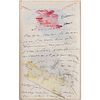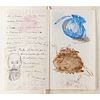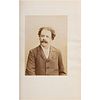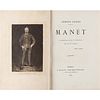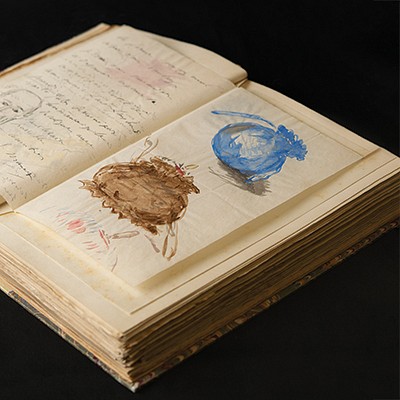Edouard Manet Illustrated Autograph Letter Signed with Watercolors
Two ways to bid:
- Leave a max absentee bid and the platform will bid on your behalf up to your maximum bid during the live auction.
- Bid live during the auction and your bids will be submitted real-time to the auctioneer.
Bid Increments
| Price | Bid Increment |
|---|---|
| $0 | $5 |
| $50 | $10 |
| $200 | $25 |
| $500 | $50 |
About Auction
Jun 14, 2023
RR Auction's June Fine Autographs and Artifacts sale boasts over 900 lots, highlighted by a special animation section of 200+ pieces of original production drawings, animation cels, and concept paintings from Disney classics like Snow White, Cinderella, and Alice in Wonderland. = RR Auction support@rrauction.com
- Lot Description
ALS in French, signed “E. Manet,” three pages on two adjoining sheets, 4.75 x 8, July 1880. Exceptional, unpublished handwritten letter to the wife of his friend Jules Guillemet, illustrated with original watercolors showing little bags (which Manet called "pochettes") of various shapes and sizes, asking her to choose a model which he will then bring her from Paris. In small part (translated): "I will probably go to Paris these days and I will bring you in exchange a pink, a yellow, or a blue to your liking. Write me what you want and the form; write me whatever you want. I'm going to ask you for lunch that day. It's not nice to have let us down on Tuesday." Manet closes by drawing a pen-and-ink portrait of the correspondent's husband, the tracing of a self-portrait by Guillemet himself: "Here is Jules drawn by himself, I trace it with all the care possible." The letter is tipped-in by its hinge to a volume labeled "Manet Recuil," containing several works on Manet. In fine condition.
For Manet, fashion and its accessories represented nothing less than modern life itself. The motif of fashion accessories is frequent in his letters, which frequently 'contain pictorial references to elements of feminine adornment: hats, little boots, handbags, parasols, etc. The hats and the bag appear as elements of a still life‰Û_These small watercolours constitute dashed-off manifestations of the same deep interest that we find in his more elaborately conceived large canvases' (cf. G. Mauner, "Un arrosoir et quelques articles de mode,' in: Manet, les natures mortes, Musée d’Orsay, 2001, p. 140).
The interesting bound volume contains three studies on Manet: 1) Edmond Bazire. Manet. Paris, A. Quantin, 1884. With 2 original etchings by Manet's "L'Odalisque couchée" and "La Convalescente" (M. Guerin, nos. 64 and 65, this one in third state), 3 etchings after Manet by H. Guérard, 6 photogravures after Manet, a facsimile of a letter to Mme Guérard, and many other illustrations. First edition of Manet's first biography, published a few months after the artist's death by his great friend. - 2) Jacques de Biez. Edouard Manet. Conférence faite à la salle des Capucines le mardi 22 janvier 1884. Paris, Ludovic Baschet, 1884. 3) Joséphin Peladan. "Le procédé de Manet d'après l'exposition de l'École des BeauxArts", L'Artiste, February 1884, pp. 101-117. - The texts by Bazire and Péladan are each preceded by a portrait of their author (vintage silver prints, 146 x 103 cm, mounted on a page before the text). Also included in the volume are a portrait of Manet (wood engraving on China paper) and a reproduction of the drawing of his "Polichinelle" (pp. [13] and 14, from an unidentified magazine, mounted and unfolded, split at center).
Provenance: 1) Madame Jules Guillemet (1850-1913), recipient; 2) "Stchukine" (probably Ivan Stchoukine [1869-1908], brother of the great collector Sergei Stchoukine, who settled in France in 1893); 3) unidentified collector who received the volume and the letters from Stchukine: possibly Plácido Zuloaga (1834-1910), whose relationship with Ivan Stchoukine is well attested; 4) Drouot sale after July 1910, Paris; 5) Valentina Zuloaga (bookplate engraved by her husband), daughter-in-law of Plácido Zuloaga and wife of the painter Ignacio Zuloaga (1870-1945); 6) Maria Rosa Suárez Zuloaga, niece of Ignacio Zuloaga; 7) French trade. - Cf. Aglaé Achechova, "Aux origines du fonds russe de la BULAC : le don ultime du mystérieux M. Stchoukine. Partie 1", 5 mars 2018. Françoise Cachin, Manet, lettres à Isabelle, Méry et autres dames (Paris, Centre Georges Pompidou, 1985). Arnauld Le Busq, Manet, lettres illustrées (Paris, 2002). Leah Lehmbeck, "'L'Esprit de l'atelier': Manet's Late Portraits of Women, 1878 -1883", in: Manet, Portraying Life (London, 2012). Manet 1832-1883 (Paris, Grand Palais, 1983). Manet and Modern Beauty, the artist's last years (Los Angeles, J. Paul Getty Museum & Chicago, The Art Institute of Chicago, 2019). Manet, Les Natures mortes (Paris, Musée d'Orsay, 2001). - Shipping Info
-
Bidder is liable for shipping and handling and providing accurate information as to shipping or delivery locations and arranging for such. RR Auction is unable to combine purchases from other auctions or affiliates into one package for shipping purposes. Lots won will be shipped in a commercially reasonable time after payment in good funds for the merchandise and the shipping fees are received or credit extended, except when third-party shipment occurs. Bidder agrees that service and handling charges related to shipping items which are not pre-paid may be charged to a credit card on file with RR Auction. Successful international Bidders shall provide written shipping instructions, including specified Customs declarations, to RR Auction for any lots to be delivered outside of the United States. NOTE: Declaration value shall be the item’(s) hammer price and RR Auction shall use the correct harmonized code for the lot. Domestic Bidders on lots designated for third-party shipment must designate the common carrier, accept risk of loss, and prepay shipping costs.
-
- Buyer's Premium



 EUR
EUR CAD
CAD AUD
AUD GBP
GBP MXN
MXN HKD
HKD CNY
CNY MYR
MYR SEK
SEK SGD
SGD CHF
CHF THB
THB
